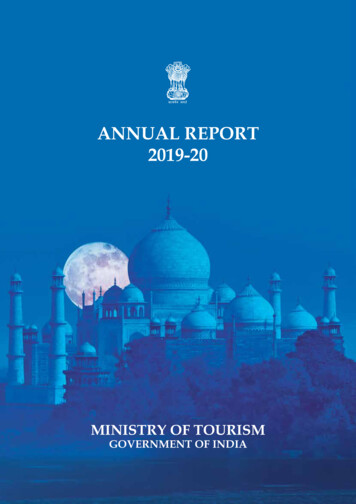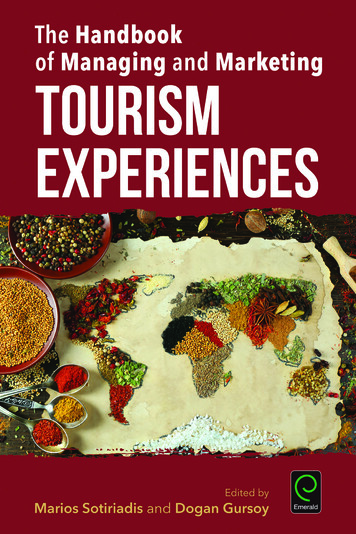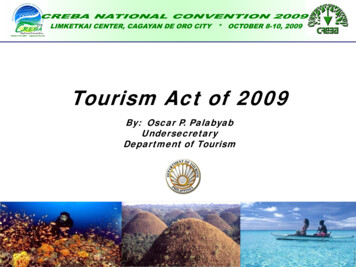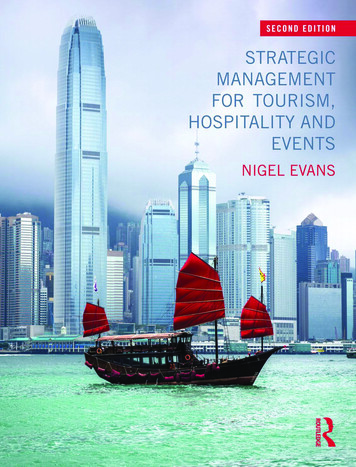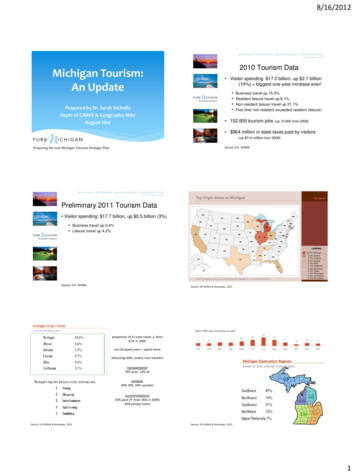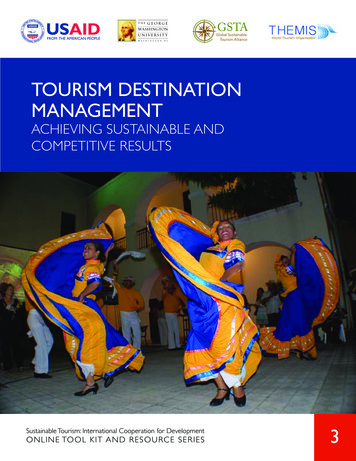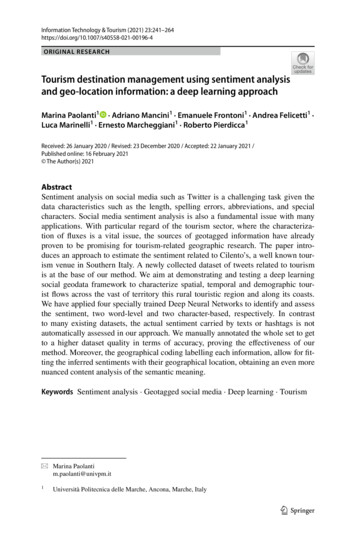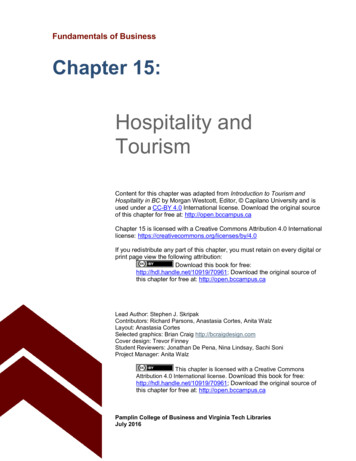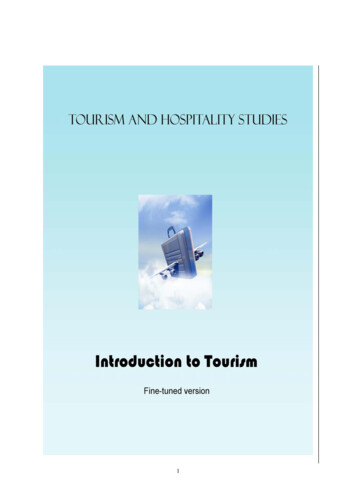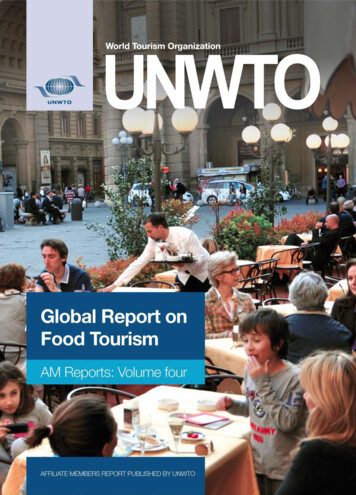
Transcription
World Tourism Organization, 2012Secretary General: Taleb RifaiExecutive Director for Competitiveness, External Relations and Partnerships: Márcio Favilla L. de Paula(4 9LWVY[Z 4HUHNLTLU[! 1H]PLY )SHUJV PYLJ[VY 5 ;6 (MÄSPH[L 4LTILYZEditorial team:Dmitriy Ilín, Project Manager, Global Report on Food TourismIñaki Gaztelumendi, Consultant, TANGIBLE - Tourism Industry ConsultantsSeries editor:Peter JordanUNWTO would like to sincerely thank all those who contributed material to this report. Copyright 2012, World TourismOrganization (UNWTO)Global Report on Food TourismPublished by the World Tourism Organization (UNWTO), Madrid, Spain.First printing: 2012All rights reserved.Printed in Spain.The designations employed and the presentation of material in this publication do not imply the expression of any opinionswhatsoever on the part of the Secretariat of the World Tourism Organization concerning the legal status of any country,territory, city or area, or of its authorities or concerning the delimitation of its frontiers or boundaries.Photos by UNWTO and DreamstimeWorld Tourism Organization (UNWTO)Calle Capitán Haya, 4228020 MadridSpainTel.: ( 34) 915 678 100Fax: ( 34) 915 713 733Website: www.unwto.orgE-mail: omt@unwto.orgCitation:World Tourism Organization (2012), Global Report on Food Tourism, UNWTO, Madrid(SS 5 ;6 W\ISPJH[PVUZ HYL WYV[LJ[LK I JVW YPNO[ ;OLYLMVYL HUK \USLZZ V[OLY PZL ZWLJPÄLK UV WHY[ VM HU 5 ;6 publication may be reproduced, stored in a retrieval system or utilized in any form or by any means, electronic or mechanical,PUJS\KPUN WOV[VJVW PUN TPJYVÄST ZJHUUPUN P[OV\[ WYPVY WLYTPZZPVU PU YP[PUN 5 ;6 LUJV\YHNLZ KPZZLTPUH[PVU VM P[Z work and is pleased to consider permissions, licensing, and translation requests related to UNWTO publications.Permission to photocopy UNWTO material in Spain must be obtained through:*, 96 *LU[YV ,ZWH VS KL LYLJOVZ 9LWYVNYmÄJVZ Calle Monte Esquinza, 1428010 MadridSpain;LS ! Fax: ( 34) 913 08 63 27Website: www.cedro.orgE-mail: cedro@cedro.orgFor authorization of the reproduction of UNWTO works outside of Spain, please contact one of CEDRO’s partner organizations,with which bilateral agreements are in place (see: http://www.cedro.org/en).For all remaining countries as well as for other permissions, requests should be addressed directly to the World TourismOrganization. For applications see: http://www.unwto.org/pub/rights.htm.7YPU[LK I ! KL[LJ[P]LNYHÄJV JVT
Global Reporton Food Tourism
CONTENTSForeward Taleb Rifai / 4Introduction / 5Gastronomy’s importance in the development of tourismdestinations in the world / 6Global trends on food tourism / 10What our Members say / 12CASE STUDIESInternational InitiativesEuro-toques in Europe:3500 artisan cooks in defence of “eating well” / 18Food and the Tourism Experience / 20Foda / 22Tourism DestinationsAzerbaijan:aromas and tastes of the East with a European twist / 26Brazil and its Paths of Flavour / 28Egypt: food tourism experience / 30Food and wine tourism in Georgia / 32Kazakhstan:tracing the country’s ancient history through its food / 34Gastronomic tourism in Korea - Globalizing Hansik / 36A taste of Moscow / 38Malaysia: at the cross-roads of Asian food culture / 40Morning pilau, or peculiarities of Uzbek cuisine / 42Business organizationsTasting Spain:the creation of a product club for gastronomic tourism / 46Food and wine tourism: Challenges and Opportunities / 48Sustainable gastronomy: Prospects for the Future / 50Fine dining:an “awakening to art de vivre” Relais & Châteaux-style / 52A brief summary of the SETE study “Gastronomy & the Marketingof Greek Tourism” / 54Educational organizationsThe Basque Culinary Center / 58Safety Food – the Brazilian Experience / 60Presentation of the B.E.S.T. concept / 62
ForewordTaleb Rifai,Secretary-General,World Tourism Organization (UNWTO)For many of the world’s billions of tourists, returning tofamiliar destinations to enjoy tried and tested recipes,VY [YH]LSPUN M\Y[OLY HÄ LSK PU ZLHYJO VM UL HUK ZWLJPHS cuisine, gastronomy has become a central part of thetourism experience.Against this background, food tourism has gainedincreasing attention over the past years. Tourists areattracted to local produce and many destinations arecentering their product development and marketingaccordingly. With food so deeply connected to its origin,this focus allows destinations to market themselves astruly unique, appealing to those travelers who look to feelWHY[ VM [OLPY KLZ[PUH[PVU [OYV\NO P[Z Å H]V\YZ This is especially important for rural communities, manyof which have struggled in the face of rapid urbanizationand shifts away from traditional economic sectors. Withtheir proximity to food-producing lands, rural communitiesoften enjoy a comparative advantage when it comesto serving up traditional fare. Tourism, particularly foodtourism, allows these communities to generate incomeand employment opportunities locally, providing jobs forvineyard tour guides or local chefs, while fuelling othersectors of the local economy such as agriculture.The Global Report on Food Tourism, the latest in the4UNWTO Global Report on Food Tourism 5 ;6 (MÄ SPH[L 4LTILYZ» ZLYPLZ VM PU KLW[O YLWVY[Z takes a closer look at the links between tourism and food,highlighting the importance of this industry to the tourismsector and economies worldwide. Bringing togetherexperiences from some of the world’s top tourismdestinations, as well as from food tourism experts, thereport offers important insight and recommendationsinto this growing segment of tourism.0 V\SK SPRL [V [OHUR HSS [OVZL 4LTILY :[H[LZ (MÄ SPH[L Members and other organizations who have contributedto this report. I trust it will serve as a delicious appetizerto the improved knowledge and continued developmentof food tourism.UNWTO Secretary-General, Taleb Rifai
The aim was to try to obtain a series of conclusionsregarding some of the initiatives that are going onworldwide in Food Tourism for possible inclusion in theZ[YH[LNPJ YLÅ LJ[PVU WYVJLZZ ILPUN JHYYPLK V\[ I IV[O the public sector and businesses about policies forKL]LSVWTLU[ HUK WYVTV[PVU PU [OPZ Ä LSK Introduction 5 ;6 (MÄ SPH[L 4LTILYZ 7YVNYHTTLIn recent years, Food Tourism has grown considerablyand has become one of the most dynamic and creativesegments of tourism. Both destinations and tourismcompanies are aware of the importance of gastronomyin order to diversify tourism and stimulate local, regionaland national economic development. Furthermore,Food Tourism includes in its discourse ethical andsustainable values based on the territory, the landscape,the sea, local culture, local products, authenticity, whichis something it has in common with current trends ofcultural consumption.;V [OPZ LUK [OL Ä YZ[ ISVJR VM [OL YLWVY[ KPZJ\ZZLZ [OL importance of gastronomy in the development of tourismdestinations in the world and reviews the global trends inFood Tourism. It also reports on the results of the survey[V OPJO 5 ;6 (MÄ SPH[L 4LTILYZ OH]L YLZWVUKLK VU the current situation of Gastronomic Tourism.The second part of the report presents case studies ofFood Tourism. First, it presents international initiativessuch as Eurotoques, an organization of chefs that includesmore than 3,500 restaurateurs from 18 countries; thestudy carried out by the OECD on “Food and the TourismExperience”; and the Slow Food movement, whichwas founded in 1986 and is present in more than 122countries.(SZV WYLZLU[LK HYL [OL L WLYPLUJLZ PU [OPZ Ä LSK I SVJHS regional and national tourism destinations, such asBrazil, Egypt, Georgia, Kazakhstan, Korea, Uzbekistanand Moscow.This new volume of the “AM Reports” series, “Global9LWVY[ VU -VVK ;V\YPZT¹ PZ HU PUP[PH[P]L VM [OL (MÄ SPH[L Members of the World Tourism Organization (UNWTO),and was produced with the support of Member States,(MÄ SPH[L 4LTILYZ [OL :PSR 9VHK 7YVNYHTTL HUK SLHKPUN WYVMLZZPVUHSZ PU [OL Ä LSK VM [V\YPZT HUK NHZ[YVUVT It also includes the experience of business organizationsPU [OL Ä LSK VM -VVK ;V\YPZT Z\JO HZ :HIVYLH ,ZWH H ;HZ[PUN :WHPU [OL Ä YZ[ W\ISPJ WYP]H[L WSH[MVYT MVY the management and promotion of Food Tourism ofSpain; the Portuguese Institute for Tourism Planningand Development (IPDT); the Hotel and GastronomyBusiness Federation of Argentina (FEHGRA); Relais& Chateaux, an exclusive collection of 475 charminghotels and gourmet restaurants in 55 countries; and theAssociation of Greek Tourism Enterprises (SETE) .In this Report, we have attempted to carry out ananalysis of the current situation of Food Tourism, throughH Z\Y]L VM [OL 5 ;6 (MÄ SPH[L 4LTILYZ HUK [OL PUW\[ of tourism and gastronomy professionals with extensiveexperience in international organizations, in destinationTHUHNLTLU[ [V\YPZT LU[LYWYPZLZ HUK PU [OL Ä LSK VM training.(UK Ä UHSS [OL YLWVY[ PUJS\KLZ [OL YLÅ LJ[PVUZ VM educational institutions, such as the Basque CulinaryCentre in San Sebastian, the National Confederation ofTrade in Goods, Services and Tourism of Brazil (CNCSENAC) and the Ecole Hôtelière de Lausanne, on theirvision and the role of human resources training in thedevelopment of Food Tourism.UNWTO Global Report on Food Tourism5
Gastronomy’simportance inthe developmentof tourismdestinations inthe worldCarmina Fandos Herrera,Senior Lecturer in Marketing, Universidad deZaragozaJavier Blanco Herranz, PYLJ[VY VM [OL 5 ;6 (MÄ SPH[L 4LTILYZ 7YVNYHTTL1VZt 4¡ 7\ \LSV (YPSSH PhD Student in Marketing, Universidad de Zaragoza/V JHU L KLÄ UL gastronomic tourism?Today, travellers are more experienced, have moredisposable income and more leisure time to travel, andthus tourism allows them to escape the daily routine of theirusual environment and immerse themselves in a world offreedom and novelty. Thus, more and more tourists in theworld are looking for concrete learning experiences, and inthis endeavour the gastronomic experience, in highly diverseways, is playing an increasingly prominent part.Current research in gastronomic tourism is scarce andis mainly focused on wine, and “oenotourists” are notnecessarily the same individuals who engage in other, nonoenological gastronomic activities.Gastronomic tourism is an emerging phenomenon thatis being developed as a new tourism product due, interalia, to the fact that according to the specialized literature(among others, Quan and Wang, 2004) over a third of touristspending is devoted to food. Therefore, the cuisine of thedestination is an aspect of utmost importance in thequality of the holiday experience.6UL VM [OL TVZ[ \[PSPaLK KLÄ UP[PVUZ VM NHZ[YVUVTPJ [V\YPZT used in the literature is that proposed by Hall and Sharples(2003), according to which food tourism is an experientialtrip to a gastronomic region, for recreational or entertainmentpurposes, which includes visits to primary and secondaryproducers of food, gastronomic festivals, food fairs, events,farmers’ markets, cooking shows and demonstrations,tastings of quality food products or any tourism activityrelated to food. In addition, this experiential journey isrelated to a particular lifestyle that includes experimentation,learning from different cultures, the acquisition of knowledgeand understanding of the qualities or attributes related totourism products, as well as culinary specialities producedin that region through its consumption. Thus, the experienceof gastronomic tourism is considered as such, provided thateverything mentioned above constitutes the main reason ormotivation to travel for visitors to a particular destination orH[ SLHZ[ VUL ZPNUPÄ JHU[ YLHZVU But even without gastronomy being the main motivationfor choosing a destination, the fact is that it is increasingly6UNWTO Global Report on Food Tourism
occupying a substantial role as a secondary or partialmotivation of tourists in the world (according to recentresearch, eating in restaurants is the second favouriteactivity of foreigners visiting the United States and is thenumber one leisure activity for U.S. travellers when theyvisit other countries).organized around an effective system of public-privatecooperation. Both approaches are inseparable and canWYV]PKL ILULÄ [Z UV[ VUS [V KPYLJ[ WYV]PKLYZ Z\JO HZ restaurants and food industries, but also other sectorsindirectly related but linked to tourism, creating conditionsfor improving local employment and the promotion of newHJ[P]P[PLZ PU aVULZ VM PUÅ \LUJL (UK [OLZL [V\YPZ[Z ZOV\SK UV[ ULJLZZHYPS IL JSHZZPÄ LK outside the scope of the product “gastronomic tourism”, OPJO [O\Z HJX\PYLZ H KLÄ UP[PVU [OH[ PZ TVYL Å L PISL and adaptable to tourism-motivation dynamics that areincreasingly plural and complex. Thus, we can take astep further and say that gastronomic tourism appliesto tourists and visitors who plan their trips partiallyor totally in order to taste the cuisine of the place orto carry out activities related to gastronomy.Gastronomic tourism comprises many different subtypesif we look through the prism of the food or dish inquestion. Thus we have, for example, offerings related toMVVK WYVK\J[Z Z\JO HZ VPS OHT JOLLZL TLH[ Ä ZO MY\P[ [Y\MÅ LZ VY JOVJVSH[L VY IL]LYHNLZ Z\JO HZ PUL ILLY whisky, cider, cognac, cava, horchata, sake, or tea.Gastronomic routes are becoming without doubt one ofthe most developed products in this area. A gastronomicroute is a system that constitutes a comprehensive andthematic tourism offering, generally branded, and isKLÄ ULK I VUL VY TVYL P[PULYHYPLZ PU H NP]LU NLVNYHWOPJ area (although in reality, gastronomy has no borders), witha series of tourism products or sites, such as factoriesand restaurants, which are listed in tourism guidebooksHUK OPJO YL]VS]L HYV\UK H ZWLJPÄ J MVVK WYVK\J[ VY dish, generally with differentiated quality, or gastronomicevents or activities. The route also informs about othersites of historical interest, thus promoting economicdevelopment throughout the area. Therefore, the idea isto bring together different types of tourist attractions andto offer them in a conveniently packaged form so thattourists stay longer in the area than if only one kind ofattraction is featured.In our opinion, gastronomic routes will be successful if theymanage to activate gastronomic heritage and convert itinto food tourism as an attraction for tourists, while at thesame time differentiating it from the competition as visitorslook for variety, new sensations and authentic experiences.But, any creation or value proposition made to strengthentravel motivations centred on gastronomy should beunderpinned by sustainability principles and practices andCarmina Fandos HerreraGastronomic tourism, lifestyle andtourism motivationsLifestyle is used in tourism to assess involvement intourism experiences. Researchers have pointed outthat culinary tourism is an authentic experience ofa sophisticated lifestyle in a pleasant environment,associated with the good life and the economic wellbeing of consuming exclusive, high-quality locally grownproducts.Tourist motivations constitute a key concept for the designand creation of products and services that add value fortourists. Motivations are related to consumer satisfactionand are considered a key component in understandingthe decision-making process of visitors. Thus, severalH\[OVYZ HYN\L [OH[ TV[P]H[PVU JHU IL PUÅ \LUJLK I physical or physiological needs (sensory perception andhedonism) security, cultural and social needs, the needto belong or interpersonal needs, the need for prestige(local delicacies), status or self-realization. In addition,UNWTO Global Report on Food Tourism7
the literature posits two dimensions for motivation: thehedonistic, with regard to aesthetic products, and theutilitarian or rational.;OLYL PZ IYVHK JVUZLUZ\Z PU [OL SP[LYH[\YL [OH[ JSHZZPÄ LZ tourist motivations as either internal stimuli or “push”,or external stimuli or “pull”. The former are consideredfrom the perspective of demand, and they lead thetourist to travel to gastronomic tourism destinations thatoften include desires as well as psychological, socialand ego-centric needs such as escapism from the dailyroutine, relaxing with family, rest, exploration and socialinteraction and affective or emotional bonding. Theresources considered pull factors are cultural and naturalattractions, special events and festivals, experiences withfood products in the destinations and other opportunitiesfor leisure and entertainment, value, friendliness ofresidents, gastronomic diversity and variety, attributes orcharacteristics of the destination such as proximity, etc.the cuisine of the destinationis an aspect of utmostimportance in the quality of theholiday experience.Tourism destination image and thegastronomic tourism experienceSeveral studies have found that tourists travel to thosedestinations that have established a reputation as aplace to experiment with quality local products.0U [OL [V\YPZT VYSK [OLYL HYL PUÅ \LU[PHS KLZ[PUH[PVUZ whose brand image is connected, with varying levels ofintensity, to gastronomic values. By way of example, itis possible to give a non-exhaustive list that includes,among others, Spain, France, Italy, Greece, Belgium,Portugal, USA (especially in areas such as California’sNapa and Sonoma Valleys), Brazil, Peru, Mexico, NewZealand, South Africa, Australia, Chile, Malaysia, Japan,0UKVULZPH )HSP *OPUH VY :PUNHWVYL 0[ PZ ZPNUPÄ JHU[ MVY example, that the Mediterranean diet of Spain, Greece,Italy and Morocco was included in UNESCO’s list ofIntangible Cultural Heritage of Humanity in November2010.As for the gastronomic tourism experience, it can beKLÄ ULK HZ [OL L]HS\H[PVU JHYYPLK V\[ I [OL [V\YPZ[ VU a number of attributes (attractiveness of the food andenvironment, quality of service), after a stay in a touristdestination where the tourist engaged in an activityrelated to gastronomy. The tourist’s perceived value ofa particular destination or establishment is thereforemultidimensional.Post-experience satisfaction is a critical indicator forassessing the effectiveness or performance of theproducts and services of the destination. The tourist’ssatisfaction with the purchase depends on the product’sperformance in relation to the tourist’s expectations.It should be kept in mind that different cultures havedifferent perceptions of satisfaction and evaluation ofgastronomy and that high quality of service can resultin dissatisfaction among consumers if their expectationshad been too high, for example, due to exaggeratedadvertising.Javier Blanco Herranz8UNWTO Global Report on Food TourismSatisfaction with the destination leads to customerloyalty and this in turn gives a higher level of intention torepeat the visit. Quality gastronomy is a decisive factorin satisfaction, as it produces a lasting memory aboutthe experience lived by the tourist. Thus, dependingon the expectations held by the consumer as to the
gastronomy of the destination, such expectations predict[OLPY SL]LSZ VM SV HS[ VY Ä KLSP[ SLHKPUN [V YLWLH[ W\YJOHZL behaviour. Here is where success lies: having touristsrevisit the destination due to its gastronomy. The festiveatmosphere, relaxation and fun experienced by the touristduring a gastronomic route, and the social interactionwith people of similar interests create associations in thetourist’s mind linked to the good times experienced bythe visitor.0[ PZ ZPNUPÄ JHU[ MVY L HTWSL [OH[ the Mediterranean diet of Spain,Greece, Italy and Morocco wasincluded in UNESCO’s list ofIntangible Cultural Heritage ofHumanity in November 2010.To recap, gastronomic tourism is a local phenomenon ofuniversal scope that is in a clear growth phase; it has apositive impact on the economy, employment and localheritage, as tourists seek to get to know not only thelocal food but also to know its origin and productionprocesses, making it an expression of cultural tourism;it has great potential for expansion as a main motivationfor tourism trips and although this type of tourism is stillpractised by a minority of tourists, the fact is that it isattracting a very select type of tourist with a high volumeof expenditure on very high-quality products, and lastly,the development of gastronomic tourism contributes toimproving the general perception of the destination.1VZt 4¡ 7\ \LSV (YPSSH1 QUAN, S. & WANG, N. 2004, “Towards a structural model of the tourist experience: An illustration from food experiences in tourism” Tourism management,vol. 25, no. 3, pp. 297-305.2 HALL, C.M. & SHARPLES, L. (2003). “The consumption of experiences or the experience of consumption? An introduction to the tourism of taste” in Food tourismaround the world. Elsevier Butterworth-Heinemann, Oxford, pp. 1-24.UNWTO Global Report on Food Tourism9
Global trendsin food tourismIñaki Gaztelumendi,Consultant on food tourism“A people that does not drink its wine and eat its cheese hasa serious identity problem.” 4HU\LS maX\La 4VU[HSImU YP[LYThe development of tourism today is paradoxical. Itsimultaneously generates processes of globalizationand enhanced appreciation of local resources. Tourismdestinations, obliged to maintain increasingly intensecompetitiveness and engaged in a constant struggle toretain some of their market, face an increasingly dynamicand sophisticated environment. The world is increasinglyopen; however, tourists seek experiences based onlocal identity and culture.In recent years gastronomy has become an indispensableelement in order to get to know the culture and lifestyle ofa territory. Gastronomy embodies all the traditional valuesassociated with the new trends in tourism: respect for cultureand tradition, a healthy lifestyle, authenticity, sustainability,experience Likewise, gastronomy represents an opportunity to revitalizeand diversify tourism, promotes local economic development,involves different professional sectors (producers, chefs,markets, etc.), and brings new uses to the primary sector.This leading role of gastronomy in the choice of destinationand tourism consumption has resulted in the growth ofgastronomic offerings based on high-quality local productsand the consolidation of a separate market for food tourism.What are the major global trends and the keys to successthat can be observed in this development of food tourism?It is a growing market. The growth of food tourismworldwide is an obvious fact. It is one of the most dynamicsegments within the tourism market.But what are food tourists like? They are tourists whotake part in the new trends of cultural consumption. Theyare travellers seeking the authenticity of the places theyvisit through food. They are concerned about the originof products. They recognize the value of gastronomy as ameans of socializing, as a space for sharing life with others,for exchanging experiences. Such tourists have higher-thanaverage expenditure, they are demanding and appreciative,10UNWTO Global Report on Food Tourism
and they eschew uniformity. Therefore, gastronomycannot become a bland and anonymous product; itmust have personality, because otherwise it will becomevulnerable, de-localized and subject to adulteration.The territory is the backbone of gastronomic offerings.The terroir is an element that differentiates and is thesource local identity. It encompasses environmentaland landscape values, history, culture, traditions, thecountryside, the sea, the own cuisine of the place. In thisregard, the conversion of the territory into a culinarylandscape is one of the challenges of tourismdestinations.The product is the basis of Food Tourism. Therefore,P[ PZ PTWVY[HU[ [V KLÄ UL OH[ OLYP[HNL YLZV\YJLZ HUK natural resources we are going to convert into tourismproducts that make it possible to identify this territory.Cultural Heritage. Culture is the set of behaviours,knowledge and customs that shape a society and onwhich a sense of belonging is based. The design ofany food tourism offering will not viable if it does nottake into account the cultural characteristics of theterritory. Gastronomy allows tourists to access thecultural and historical heritage of destinations throughtasting, experiencing and purchasing. That is, it makesit possible to approach culture in a more experiential andparticipatory way that is not purely contemplative.We must also take into account the emergence of newcultural values, which increase the richness and culturaldiversity of the country.In this regard, Tradition and Innovation coexist in anatural manner. Gastronomic tradition is in a process ofcontinuous evolution, and the challenge for professionalsis to incorporate innovation in order to renew and adapttheir offerings to the needs of the new cultural consumer.Sustainability. Food tourism is capable of addressingcultural and environmental concerns in a way thatis compatible with purely economic arguments. Therecent history of global tourism development is litteredwith nominally sustainable models and manifestlyunsustainable actions. The idea is not to create newindiscriminate pressure on culinary heritage, but toleverage it rationally with an eye to sustainability. It isnot about “touristifying” gastronomy, by creating newofferings or scaling up existing ones. It is not so muchabout creating in order to attract, but rather attractingvisitors to participate in the destination’s own culturalreality, well explained and interpreted, through cuisine,local products and all the services and activities thatsurround them.Quality. Destinations that want to promote food tourism have[V VYR VU ]HYPV\Z SL]LSZ PU [OL Ä LSK VM X\HSP[ ! [OL WYV[LJ[PVU and recognition of local products, the development of acompetitive offering, the professionalism of human resourcesthroughout the value chain of food tourism through trainingand retraining, and consumer protection and reception inorder to increase visitor satisfaction.Communication. Destinations must articulate acredible and authentic narrative of their food tourismofferings. The travel experience has changed and is notlimited to the days of actual travelling, but rather it startsmuch earlier, with its preparation (the tourist becomesinspired, gathers information, compares, purchases),and the experience ends when the traveller assessesand shares his experiences through social networks.Playing key roles in the process are: the great chefs whohave ignited a revolution in the segment of high-endcuisine as a revitalizing element for tourism, the media(especially television), tourist guides, food blogs andsocial networks in the image building of a destination.And destinations must be present in all channels and allparts of this process.Cooperation. It is necessary for the actors operating in[OL KLZ[PUH[PVU WYVK\JLYZ MHYTLYZ YHUJOLYZ Ä ZOLYTLU chefs, restaurateurs, public administrations, hoteliers,L[J [V IL PU]VS]LK PU [OL KLÄ UP[PVU HUK THUHNLTLU[ VM food tourism product offerings.Iñaki GaztelumendiUNWTO Global Report on Food Tourism11
What ourMembers sayWith a view to the publication of the Global Report on FoodTourism, a survey was conducted among the UNWTO(MÄ SPH[L 4LTILYZ PU VYKLY [V RUV [OLPY VWPUPVU HIV\[ [OL J\YYLU[ ZP[\H[PVU VM -VVK ;V\YPZT 9LZWVUZLZ MYVT (MÄ SPH[L Members, working in diverse sectors around the world,were received in this regard.StrategyAccording to the results this survey, 88.2% of respondentsJVUZPKLY [OH[ NHZ[YVUVT PZ H Z[YH[LNPJ LSLTLU[ PU KLÄ UPUN the brand and image of their destination. Only 11.8% wereof the opinion that gastronomy plays a minor role.“gastronomy is a strategicLSLTLU[ PU KLÄ UPUN [OL IYHUK and image of their destination”However, a smaller percentage of respondents believethat their country has its own gastronomic brand: only YLZWVUKLK PU [OL HMÄ YTH[P]L 0U MHJ[ H JVUZPKLYHISL percentage (32.3%) believe that their country has notstructured its own brand of gastronomy, meaning that, ingeneral, destinations still have some ways to go in terms of[OLPY Z[YH[LNPJ YLÅ LJ[PVU VU NHZ[YVUVTPJ [V\YPZT Gastronomic CultureAmong the elements of the gastronomic culture of thedestination which they consider should be featured inpromotional campaigns today, most respondents citethe quality, variety and regional diversity of foods, notably,VSP]L VPS PUL ZWPJLZ Ä ZO HUK ZLHMVVK YPJL ]LNL[HISLZ meat, etc. As added value they lean towards broaderconcepts such as the Mediterranean diet, included on theUNESCO World Heritage list, healthy cooking, sustainability,or multiculturalism. They also point to the importance ofrestaurant offerings with a strong local basis (Mediterranean,oriental, ethnic, etc.) that combine tradition and innovation,and the role of international cuisine.;V\YPZT 7YVK\J[ZAs for gastronomic tourism products that exist in theirKLZ[PUH[PVU [OL VYNHUPaH[PVUZ JVUZ\S[LK \UKLYSPULK PU [OL Ä YZ[ place the importance of food events (expressed by 79% of12UNWTO Global Report on Food Tourism
respondents).This is followed by gastronomic routes andcooking classes and workshops, with 62% answeringHMÄ YTH[P]LS MVVK MHPYZ MLH[\YPUN SVJHS WYVK\J[Z and visits to markets and producers (53%). Having lessweight among gastronomic tourism product offeringsare museums (cited by only 12% of respondents), andpresentations with 6% of positive answers.4HYRL[PUN HUK 7YVTV[PVU68% of the organizations consulted carry out marketingactivities or promotion based on Food Tourism. Themarketing and promotional tools most used by theseentities are: organizing events (91%), producing brochuresand advertising (82%) and dedicated websites on foodtourism (78 %). At a lower level are promotional tools suchas tourism guides (61%), blogs (43%), and familiarizationtrips for journalists and tour operators (13%). And lastly,only 4% of the organizations surveyed said they usedsocial networks for the promotion of food tourism.UNWTO Gl
International Initiatives Euro-toques in Europe: 3500 artisan cooks in defence of “eating well” / 18 Food and the Tourism Experience / 20 Foda / 22 Tourism Destinations Azerbaijan: aromas and tastes of the East with a European twist / 26 Brazil and its Paths of Flavour / 28 Egypt:
